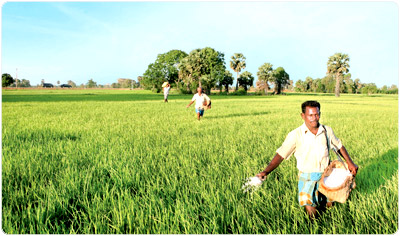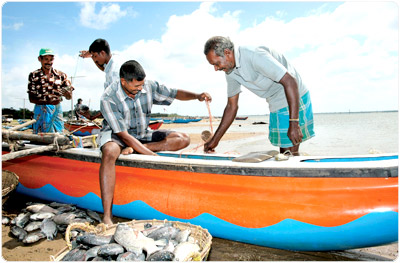Sri Lanka’s success
story:
Resettlement in double quick time
By S. Thillainathan
Around 95% of people settled in Menik
Farm soon after terrorism ended in May 2009, were resettled in their
original habitat. To be exact, 94.5% were resettled in their original
habitat. It can be “a Sri Lankan success story” S.B. Divaratne, Advisor
to the President and Secretary, Presidential Task Force for
Resettlement, Development and Secretary in the Northern Province said in
an exclusive interview with the Sunday Observer.
|

S. B. Divaratne |
In addition to this, 35,000 wells were either reconstructed or
repaired in the Northern Province to give pure drinking water to the
people resettled in their original hometowns. They are provided clean
toilets and other facilities for a clean environment Divaratne said.
Of the 1,026 schools in the Northern Province 650 schools had no
roofs. Now, after rehabilitation and reconstruction 989 schools are
functioning. The total number of students in the Northern Province is
260,582, and the total number of teachers is 13,967. The government has
spent 1.3 billion rupees to repair the schools, Dayaratne said.
|

Farmers in anticipation of a rich harvest after three decades |
Sri Lanka, from time to time experienced natural and man-made
catastrophes that resulted in civilians being displaced but faced the
consequences of each one of them bravely and dealt with the ensuing
challenges encompassing recovery, resettlement, reconstruction and
return of the displaced with remarkable success. The most recent
experience which may be termed “a Sri Lankan success story” is what took
place in the resettlement of the displaced persons after ending the 30
year-war against terrorism.
These were the opening remarks by Divaratne, explaining resettlement.
He said the resettlement that took place in 2009 was basically to
resettle those who were accommodated in the welfare centre in Manik
Farm. The government handled the operations by initiating priority
policies and strategies to effectively carry out the task and it is not
an adhoc arrangement. That is why we have been able to make a
significant achievement in the resettlement of displaced persons.
Divaratne said four criteria resettlement was implemented. The first
resettlement process is voluntary. Second, displaced persons should be
resettled in their original places of habitation. Third, the process
should be dignified and safe and fourth the Sri Lanka army will be part
of the resettlement.
Divaratne explaining their achievements said by now, we have been
able to resettle nearly 142,230 families (498,838 persons), not only the
families accommodated in the welfare centre but an equal number living
with friends and relatives were also resettled during this period.
He said the resettlement process is almost over except for some
families in the Jaffna and Mannar Districts. In Jaffna there are 7,830
families to be resettled and action is being taken to resettle them when
the lands retained by government is released.
Speaking on the restoration of the health services in Kilinochchi
which was badly damaged during the 30 year war against terrorism the
restoration of health care services includes renovation of damaged
health institutions, reconstruction of new buildings and procurement of
equipment. The total expenditure for rehabilitation of health care
between 2009-2011 amounts to Rs. 2,135 million and Rs. 9,254 million has
been allocated for ongoing projects. Divaratne explaining the Northern
Province education said there are 1,020 schools in the North. Of this,
nearly 991 schools are functioning since 2009. 1,630 school buildings
have been repaired at a cost of Rs. 1,341 million. There are 13,967
teachers catering to 260,582 students.
|

Fishermen get ready for a big catch |
The student-teacher ratio in the Northern Province is almost the same
as the national average. When you compare the capital allocation and per
capita expenditure in the health sector during this period with the
other provinces it is an impressive record. The net result is
malnutrition of children 1-2 years has been significantly reduced and
the number of dengue cases reported between 2010 to 2012 reduced
compared to other provinces, he said. Explaining the housing project, he
said 78,000 permanent houses will be built of which 27,983 houses have
already been completed. The government has made substantial investments
to improve connectivity. All major highways are being rehabilitated.
These include major roads, provincial roads and rural roads. The total
investment is Rs. 7,500 million.
The number of vehicles registered for the province had increased from
47,031 in 2009 to 62,644 in 2011. Rehabilitation of the railway network
has begun at a cost of US $ 652 million. The rail service from Omanthai
to Madu will be extended from May 14, he said.
In Agriculture, theGovernment’s action plan is a tremendous success.
It is the most vital economic sector providing basic food security, and
livelihood for 80% of the population. The revival include restoration of
the entire irrigation network, clearing of abandoned paddy lands and the
supply of inputs for agriculture. 90% of abandoned cultivable paddy
lands are now cleared. The extent of land for agriculture increased to
193,200 acres and a production of 212,722 metric tons of paddy has been
recorded.
Explaining the irrigation projects, Divaratne said the reconstruction
work on 2,000 minor and medium tanks has been completed. About 189,000
acres come under the irrigated water scheme. The total cost is Rs. 6,334
million. The contribution of the Northern Province to national fish
production increased to 11 percent. The total fish production of the
Northern Province had increased from 21,880 metric tons in 2009 to
48,520 metric tons in 2011. There are nearly 50,000 active fishermen in
marine and inland fisheries. Daily 28 freezer trucks transport fish to
Colombo from the Northern Province which was almost nil in 2008,
Divaratne said. |


